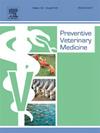A retrospective case-control study of pregnancy failure in Thoroughbred horses in Australia
IF 2.2
2区 农林科学
Q1 VETERINARY SCIENCES
引用次数: 0
Abstract
Pregnancy failure is a serious economic and welfare concern in the Thoroughbred horse industry, yet its incidence and risk factors in Australia remain unclear. This retrospective, nested, case-control study investigated pregnancy failure in resident mares on studs in the Hunter Valley, Australia, in 2021—2022, in early (46–150 days), mid (151–270 days), and late (>270 days) gestation. We found an annual incidence risk of 5.4 pregnancy failure cases/100 45-day pregnancies (0.05 cases/mare; 95 % CI 0.04—0.07), with full-term (perinatal) losses (≥320 days) accounting for 24 % of cases (95 % CI 14—37 %). There was no significant difference in loss according to mare age or reproductive history. Control mares had nearly six times higher odds of being vaccinated against Salmonellosis (Salmonella enterica subsp enterica serovar Typhimurium) compared to case mares (OR 5.92, 95 % CI 1.2—29.7). Environmental factors like paddocks with native trees were also associated with increased losses. The study provides evidence that Salmonella sp. might be an important cause of pregnancy failures in Australia. In addition, the findings contribute valuable baseline data for developing targeted surveillance strategies for pregnancy failure in Australian Thoroughbreds. Further investigation of factors such as Salmonella sp. is warranted to enhance breeding success and ensure welfare of Thoroughbred mares in Australia.
求助全文
约1分钟内获得全文
求助全文
来源期刊

Preventive veterinary medicine
农林科学-兽医学
CiteScore
5.60
自引率
7.70%
发文量
184
审稿时长
3 months
期刊介绍:
Preventive Veterinary Medicine is one of the leading international resources for scientific reports on animal health programs and preventive veterinary medicine. The journal follows the guidelines for standardizing and strengthening the reporting of biomedical research which are available from the CONSORT, MOOSE, PRISMA, REFLECT, STARD, and STROBE statements. The journal focuses on:
Epidemiology of health events relevant to domestic and wild animals;
Economic impacts of epidemic and endemic animal and zoonotic diseases;
Latest methods and approaches in veterinary epidemiology;
Disease and infection control or eradication measures;
The "One Health" concept and the relationships between veterinary medicine, human health, animal-production systems, and the environment;
Development of new techniques in surveillance systems and diagnosis;
Evaluation and control of diseases in animal populations.
 求助内容:
求助内容: 应助结果提醒方式:
应助结果提醒方式:


